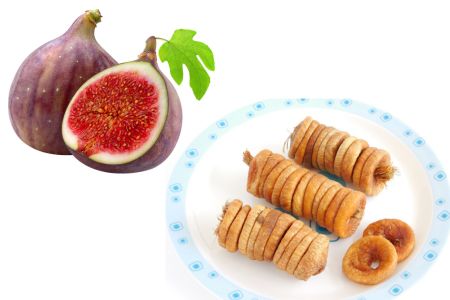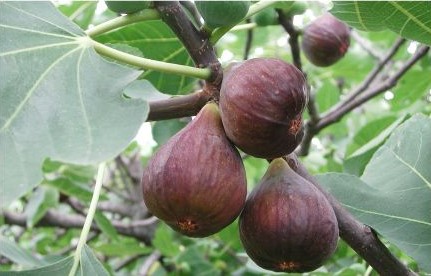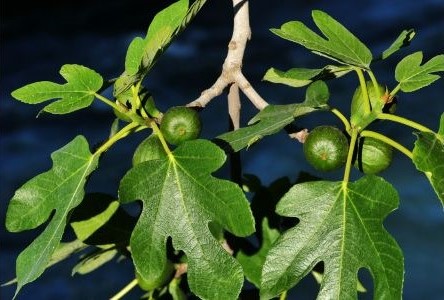Anjeer Uses, Medicinal Qualities, Remedies, Research

By Dr Renita D’Souza
Table of Contents
Introduction
Anjeer (Ficus carica) is a very well-known nutritive fruit with many medicinal virtues. It helps in quick recovery from fatigue and endows the body with good physical and mental strength. Classical term of Anjeer fruit is Phalgu. It is described under Phala varga in Priya Nighantu. Leaves and roots of this plant are used in cardiovascular diseases, sore throat, cough, indigestion, colic, loss of appetite, diarrhoea and other respiratory and gastrointestinal diseases. Also used as anti-inflammatory agents. Fresh and dried figs possess laxative properties. Dry fruit is used as good nutritional support for diabetes.
Read – Udumbar – Ficus racemosa Uses, Research, Side Effects

Botanical Name – Ficus carica
Family – Moraceae
Medicinal Qualities
Ripe fruit of Anjeer possess following qualities
Taste (Rasa) – Sweet
Quality (Guna) – Guru (heavy to digest)
Snigdha (unctuous)
Potency (Virya) – Shita (cold)
Vipaka (Taste after digestion) – Sweet
Action (Karma) –
Tarpana – Nutritive
Balya – promotes physical strength
Anulomana – helps easy evacuation of bowels
Vibandam Hanti – cures constipation
Shramahara – relieves fatigue
Brahmana – Nourishing
Vishtambhi – constipating (excess use)
Yakkrit uthejjaka
Vrshya – Aphrodisiac
Mutrala – diuretic
Dahaprashamana
Raktashodhaka – Purifies blood
Kaphanisaraka – Expectorant
Read – Banyan Tree: Ficus benghalensis: Uses, Research, Remedies, Side Effects
Effect on Doshas
Vatapittahara – Balances aggravated vata and pitta dosha
Remedies
- Latex of Fig is applied externally on warts, skin ulcers and sores. It is also used as a purgative and anthelmintic.
- Fruit paste is applied externally on swellings, tumour and inflammations. It acts as the best pain relieving agent.
- In Hemorrhage, fruit juice with honey is given internally. (Vrindamaadhava)
Pharmacological Activities
Ficus carica possess Anticancer, Antioxidant, Antidiabetic, Antifungal, Antibacterial, Hepatoprotective, Anti-inflammatory, Gastroprotective, Antidiarrheal, Antitumor, Antispasmodic, Immune Balancing, Antipyretic and Antimutagenic activities.
Leaves of Anjeer possess Diuretic, Demulcent, Emollient and Anthelmintic properties.
Nutritive value of Figs
Figs (Ficus carica) contains Protein 1.3 g, Fat (total Lipids) 0.2 g, Carbohydrates 7.6 g, Calories (energy) 80 k Cal, Moisture 88.1 g, Fibre 2.2 g, Minerals 0.6 g, Thiamine 0.1 mg, Calcium 35 mg, Phosphorus 22 mg, Iron 0.6 mg, Vitamin A – 80 IU and Vitamin C – 2 mg
Read – Ashmantaka – Ficus rumphii – Uses, Dose, Research

Therapeutic Uses
Anjir can be used in diseases such as-
Constipation
Liver and Spleen diseases
General debility
Jaundice
Sandhivata – Osteoarthritis
Vataraktha – gout
Rakta vikara – diseases related to blood
Raktapitta
Sore throat, Cough, Asthma
Ashmari – urinary calculi
Vrikka shula
Mutrakricchra – dysuria
Shukra dourbalya – Oligospermia
Burning sensation
Vrana – wound
Visphota – Boils
Masurika – measles
Fever
Fruits are used in –
Leprosy
Nose bleeding
Antipyretic
Aphrodisiac
Lithontriptic
Hair nutritive
Emollient
Demulcent
Laxative
Inflammation
Paralysis
Liver diseases
Chest pain
Piles
Roots are used in –
Leucoderma
Ringworm infection.
Latex is used as –
Expectorant
Diuretic
Anthelmintic and in the treatment of anemia.
Leaves are used as –
Antidiabetic
Vermifuge
In contact dermatitis
Seeds are used as edible oil, lubricant etc
Read – Pears Fruit Uses, Medicinal Qualities, Research, Remedies
Part Used
Fruit, Leaves, Root
Dosage
Juice – l0-20 ml
Paste – 5-10 ml
Dried fruit – 2-3
Sanskrit Verses


Botanical Description
Ficus carica is a moderate sized deciduous tree growing up to 15- 20 ft in height. Leaves are broad, ovate, nearly 3-5 lobed, leathery dark green above and hairy below.
Fruits are axillary, usually pear shaped, variable in size and color, when ripe it is sweet and juicy. It is gummy with latex before ripening. Although fig is considered as a fruit is actually a flower inverted into it. Seeds are many and vary greatly in size. Seeds are real fruits in figs.
Plant latex is milky white and it contains a protein digesting enzyme called Ficin.
Read – Apple Benefits, Qualities, Remedies, Research
Distribution
Ficus carica is native to Carica in Asia minor. It is distributed in Southwest Asia and the Eastern Mediterranean region, from Turkey in the East to Spain and Portugal in the West. It is also grown commercially in parts of the U.S.A., Chile, Arabia, Persia, India, China and Japan.
Controversy
In Charaka and Sushruta Samhita, Phalgu is mentioned as Vishtambhi (constipating). Priya Nighantu mentions properties of Anulomana and Vibanda hanti that helps in relieving constipation.
Other Nighantukaaras and commentators such as Dalhana and Chakrapaani mentions Phalgu as synonym of Kaakodumbara (Ficus hispida).
Read – Ficus hispida – Kakodumbara Uses, Research, Remedies, Side Effects
Research
Anticancer Activity – The study ‘Anticancer Activity of Methanol Extract of Ficus carica Leaves and Fruits Against Proliferation, Apoptosis, and Necrosis in Huh7it Cells’, have shown that the leaf extract of Ficus carica have higher anticancer activity compared with its fruit extracts.
Anti-inflammatory Activity– A research study conducted to evaluate Anti-inflammatory activity of leaves of Ficus carica have shown that the petroleum ether (PEE), chloroform (CE) and ethanol (EE) extracts have greater anti-inflammatory effect comparative to standard drug Indomethacin.
Classical Categorization
Priya Nighantu – Phala varga
Charaka Samhitha –
Shramaharani Dashemaani
Phala Varga
Sushrutha Samhitha – Phala Varga
Formulations
Whoopin Syrup – It relieves distressing cough
Gojihwadi Kashaya – It is used in the treatment of fever, cough, bronchitis etc Nila ghritha – Used in asaadhya kushta (Su.Chi 9/29)
Nila ghritha – Used in asaadhya kushta (Su.Chi 9/29)
Scientific Classification
Kingdom – Plantae
Subkingdom – Tracheobionta
Superdivision – Spermatophyte
Division- Magnoliphyta
Class – Maghnoliosida
Subclass – Hamamelididae
Order – Urticales
Family – Moraceae
Genus – Ficus
Species – carica
Vernacular Names
English Name – Common fig
Sanskrit Name – Phalgu phalam
Hindi Name – Anjeer
Marathi Name – Anjra
Bengali Name – Anjir
Kannada Name – Anjura
Malayalam Name – Shimi atti
Tamil Name – Simayiatti tenatti
Telugu Name – Anjura, Manjimedi, Shimi atti
Punjabi Name – Fagari
Arab Name – Tin
Persian Name – Anjir
Click to Consult Dr Renita D’Souza
Systemic Action (Sthanika Karma)
External – Warm paste is used to apply on inflammatory wounds.
Digestive System – Liver stimulant, indicated in Splenomegaly, hemorrhoids, Jaundice etc. Facilitate normal movement of doshas.
Circulatory System –Indicated in joint inflammation, blood borne diseases, bleeding diseases etc.
Respiratory system – Expels out vitiated kapha dosha, indicated in cough, breathing diseases etc. by improving the mucosal health of respiratory passage.
Excretory system – Improve urine output, indicated in Urinary calculi and associated pain, Dysuria etc.
Reproductive system – Aphrodisiac. It can be used with other herbal medicines to increase sperm count.
Skin – Improve complexion, cure burning sensation associated with skin irruptions.
Satmikarana – Indicated in general debility. promote strength.
Tapakrama – jvaraghna (fever and associated weakness)








